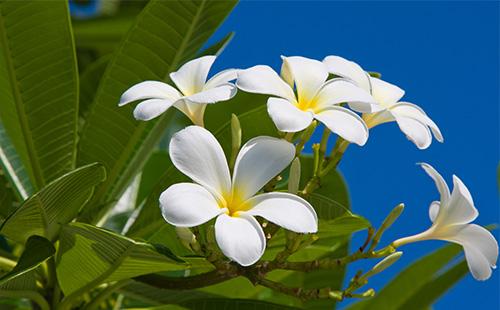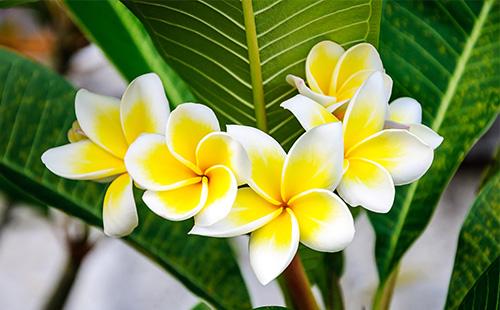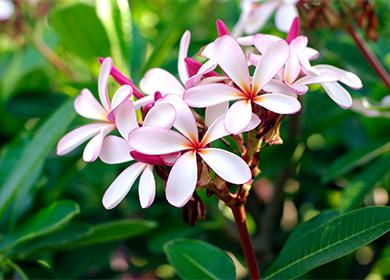The content of the article
A wonderful guest is a resident of the tropics. At home, in a natural environment, it grows up to 8 m. The hallmark of plumeria (or frangipani) is its exquisite aroma. The smell is multifaceted and able to change, "adapting" to environmental conditions. It was he who became the basis of the perfumes of Frangipani. The army of fans who want to admire and inhale the aroma of a tropical plant is constantly growing.
Botanical Description
A beautiful flower with a delicate aroma in conditions of indoor cultivation usually reaches 2 m. Plumeria is not capricious and, despite its tropical "roots", feels comfortable in large spacious rooms. The following features are characteristic of a tropical guest.
- The escape. Thick shoot with short internodes. The stalk is bare, gray-brown.
- Leaves. Rosettes with leaves are formed on the tops of the shoots. They are different in size, but necessarily have a longitudinal vein. The top surface of the sheet is glossy and darker than the bottom.
- Flowers. Up to 20 flowers can be formed on one plumeria. Large fragrant flowers vary in shape and color, depending on the species. The aroma of the plant is enhanced in the morning and late evening.
- Fruit. Cylindrical pods of a greenish or brown shade. They contain plant seeds, large and flat.
4 types for window sill
The genus Plumeria is not numerous. Only nine types of culture are known that grow in the subtropics and tropics of America. And at home, you can observe only four types of frangipani.
- White. A small tree with branching stems. Large leaves, with slightly raised edges, reach 30 cm. White flowers (diameter 3 cm) contain five dense petals. The core of the flower is yellow.
- Red. This tree is small. Leaves can grow up to 50 cm, differ in ovoid shape. Wax flowers reach a diameter of 6 cm. They are formed exclusively on young branches. The main color is red. But depending on the variety, the flowers can be lilac, yellow pink or even two-tone, with blurred borders between tones. Plumeria also vary in form. Sometimes there are flowers twisted in a spiral or significantly overlapping.
- Dumb. The plant is slightly dulled and looks more like a bush. Large leaves (about 18 cm in length) have a rounded edge. White petals with a yellowish base form a flower, the diameter of which varies from 1.5 to 4.5 cm.
- Bashful. A semi-dwarf species, characterized by abundant flowering. A characteristic feature of the plant is an unusual, concave inward, leaf shape (spoon-shaped). White flowers, with wide oval petals and a yellow core, are completely devoid of aroma.
Actions after the purchase
The plant comes to the store’s counter from the greenhouse, which created the perfect microclimate for the development of culture. It is transported and sold in a container with rather scarce soil. Therefore, plumeria cannot live long in such an environment. However, you should not rush with a transplant. Florists give three recommendations on how to ensure proper plant care after purchase.
- Quarantine. The flower is experiencing real stress from a change of residence. Therefore, he needs to settle down in the new conditions. Give one week to learn a new pet. Find him a place with calm diffused light, without drafts and separately from other plants, do not water and do not rush with top dressing.
- Track status. After quarantine, “relocate” the Tropicana to the sunniest window sill. Provide plumeria with proper care. Carefully see how the flower reacted to a new place, watering, lighting. If he doesn’t like something, he will immediately let you know about it.
- Take your time with the change. Despite the scarcity of soil, it is best to leave it in this container. But if roots peek out from the pot, then transplants cannot be avoided.
Flowering Care
A resident of tropical countries is not capricious, but needs to create certain conditions. Compliance with all the "requirements" of an exquisite beauty will allow you to enjoy beautiful flowering and delicate aroma throughout the year.
Lighting and seat selection
The plant is very photophilous. It is able to easily tolerate direct sunlight. And the absence of light or diffused lighting will lead to a gradual withering of the culture. To ensure a comfortable plumeria, consider the following three points.
- A lot of light. It is better to put the pot on the southern windows. If they are not in the house, then you can allocate a place for plumeria on the eastern windowsills. There should be no drafts in these areas.
- Time. The plant should receive direct light for at least six hours a day. Otherwise, the buds simply will not form.
- Summer hardening. In summer, it is recommended that plumeria be brought to the balcony or terrace. So tender petals will receive more sunlight. But the plant should be accustomed to fresh air gradually. Carefully approach the choice of place. Frangipani must be protected from gusts of wind and drafts.
Temperature
The photophilous southerner does not require heat. But it needs stable performance and does not tolerate sharp temperature extremes. Plumeria dies in excessive heat and does not tolerate cold.
The following conditions are optimal:
- summer - frangipani develops comfortably and blooms at 22-26 ° C;
- in winter - during rest, the culture requires 16-18 ° C.
Humidity and watering
Plumeria is very fond of water. She can't stand the drought. If the soil in the pot is completely dry, then the root system of the plant will die. Resuscitate such a plumeria will not work. To recreate the necessary humid climate, you must adhere to the following three rules.
- Watering. Do not spare water and moisturize the flower with all your heart. All soil must be saturated with moisture. But no need to fill the plant. As soon as the topsoil dries out a little, it is necessary to water the plant again.
- Humidity. To ensure the necessary humidity, it is recommended to lay out wet moss in the pan. The pot itself is best placed on expanded clay or pebbles, pre-filled with water.
- Spraying. It is necessary to gently moisten the plant.Spray the culture from the spray gun. In this case, droplets of liquid should not fall on the inflorescences. Flowers must be protected as much as possible from splashes. In the heat, spraying is carried out twice a day.
Top dressing
Plumeria grows very fast. A plant expends a lot of energy on pasturing leaves, therefore it often experiences a deficiency in nutrients. To maintain the flower and ensure its normal development, periodically fertilize. Florists are advised to adhere to two recommendations.
- Start of vegetation. They begin to fertilize immediately after a period of rest. At this time, the plant begins to actively grow leaves. For their full development, fertilizers enriched with nitrogen are required. They are brought in once a week.
- Bud ovary. When the crown turns green, nitrogen must be discarded. This fertilizer provides leaf growth, but inhibits the flowering process. During this period, fertilizing is enriched with phosphorus and intended for flowering crops. Fertilize the culture every seven to ten days. In this case, the plant requires both root dressing and foliar (spraying on the leaves).

4 hibernation rules
In winter, the plant begins to actively discard old leaves. So plumeria signals a period of rest. At this time, growth slows down. But even now, frangipani needs care. During the rest period, care is carried out according to four rules.
- Temperature change. Gradually lower the temperature. Sharp changes are strictly prohibited. Do not put the pot on a cold surface. The root system may freeze.
- Change of place. During dormancy, the plumeria does not need bright light. It can provoke a new vegetation period of an unrefreshed plant.
- Watering reduction. But watering should not be completely ruled out. It is necessary to constantly monitor the condition of the soil and periodically moisten it, so as not to dry the root system.
- Fertilizer rejection. Feeding a plant during dormancy should not be. Fertilizing will provoke the beginning of the growing season.
Pruning
Crown cutting is a must. Such an event allows you to give the plant a more compact form, eliminate excess and diseased shoots. Do not be afraid of such an event. In place of the cut branches, new ones will appear. And after trimming, they grow much more actively. Consider two recommendations.
- Pruning time. Removal of shoots begins at the very end of the dormant period, on the eve of the growing season. If you miss this moment, then at the ends of the branches buds will begin to be laid, and as a result of pruning, flowering will not occur.
- Shoot removal. All sick, weak branches are cut off. Shoots that are too long must be shortened. If blackened tips are observed, then they are cut to living tissue. Please note that only young shoots are pruned.
Transfer
Before vegetation, the plant must be transplanted. But this applies only to young specimens. Young plumeria is transplanted every year. A plant over four years old is not recommended to be touched, because this is already a real tree. To transplant a culture, use three recommendations.
- Pot selection. The new flowerpot should be 3-4 cm larger in diameter to ensure normal development of the plant.
- Soil selection. Soil can be purchased or made independently. To prepare the soil, soddy soil, humus, river sand and peat are combined in the appropriate proportions: 2: 1: 1: 1. The finished mixture for disinfection is roasted in the oven or spilled generously with fungicide.
- Transplant process. A drainage layer (2 cm) of shards, pebbles, expanded clay is laid at the bottom of the pot. Pour some soil. Set the plant. It is sprinkled on all sides with soil and a little tamped. Moisturize and, if necessary, add soil.
2 breeding methods
If you want to have a whole family of plumeria, then you have to figure out how to propagate the plant. Florists offer two ways: seeds and cuttings. The methods are pretty simple. And both will allow you to get beautiful flowers. So the choice is yours.
Seeds
About a tenth month after the start of the growing season, the fruits ripen on the plumeria. When the pods get a brown tint and begin to dry, the raw materials are carefully collected. They split and take out the seeds. Follow the eight-step algorithm below.
- Stimulation. Moisten two pieces of cloth in warm water with a growth stimulant. Spread the seeds between these cuts. Leave them for two to three hours.
- Individual pot. For each seed, prepare your own pot of peat so as not to injure the plant in the future.
- Landing. The seed is planted so that its quarter (wing) remains above the ground.
- The greenhouse device. Pots are covered with glass or stretched film.
- Watering and airing. The soil must be watered. Periodically, the glass is removed and aerated for future culture. The room temperature should correspond to 23-25 ° C.
- The emergence of seedlings. Approximately on the tenth day, the seeds take root, a stalk appears.
- Cleaning up. The cotyledons formed on the stem must be carefully cleaned of the film. If this is not done, then the process of decay may begin and save the plant will fail.
- Transfer. When the root is “stronger”, large leaves will form, they can be planted in large pots.
Cuttings
Using cuttings, it is much easier to propagate plumeria. In addition, the children remain after the mandatory pruning of the plant before the growing season. But only strong and healthy shoots are suitable for planting. The breeding algorithm consists of seven steps.
- Selection. Strong cuttings are selected, 25-30 cm long. They must be cut at an acute angle.
- Treatment. It is recommended to lower the cut into the special root-forming preparation before planting.
- Landing. Then the stalk is planted in the ground, deepening into the soil by 10 cm. Water abundantly.
- Seat selection. The container with the future plumeria is placed in a warm and rather bright place.
- Watering. Periodically, as the earth dries up, the soil is watered.
- Rooting. Be patient, as the rooting process can take up to three months.
- Transfer. A strong and healthy plant, with well-shaped leaves, can be transplanted into a new pot.
Diseases and Pests
Plumeria is very rarely ill and practically does not undergo attack by pests. The plant rescues poisonous juice from unpleasant insects. However, not from everyone. Sometimes the southern tropicana begins to languish before our eyes or completely refuses to bloom. How to help plumeria regain its former beauty?
Lack of flowering
The reasons why frangipani does not bloom are many. And most often they are hidden in improper care. Growers indicate the following risk factors:
- lack of light;
- incorrect transplantation or its ignoring;
- insufficient feeding;
- incorrect pruning of the crown;
- strong cutting of roots.
Leaf wilt
If the plant began to dry leaves, then this does not always indicate a problem. Perhaps the growing season has come to an end, and plumeria is preparing for a dormant state. But if the beautiful frangipani has the peak of flowering, and the leaves began to turn yellow and wither, then the problem can also be hidden in insufficient care. The causes of wilting may be:
- lack of moisture;
- lack of fertilizer;
- sudden changes in temperature or lighting.

Spider mite
The only pest that is not afraid of the poisonous juice of plumeria is a spider mite. It affects the plant with a lack of watering. Identify it is easy. He leaves small thin cobwebs on the inside of the leaves.Treatment methods include three recommendations.
- Watering. Strengthen the watering of the flower.
- Spraying. Spray the plant with warm water daily. Repeat the procedure twice a day.
- Treatment. Treat plumeria with a fungicide solution. Repeat the procedure after ten days.
Root decay
Observed with excessive watering. Excessive moisture leads to acidification of the soil and rotting of the roots. Most often this happens in the winter, during the dormant period. You can rid the plant of this disease with the help of a transplant. Follow the instructions in four steps.
- Cleaning up. The rhizome is thoroughly cleaned of soil.
- Pruning. All rotted areas are cut off.
- Treatment. Slices are treated with wood ash.
- Landing. A new soil is prepared, in which plumeria is planted.
Do not forget that the southerner is poisonous. Therefore, when planning a transplant or pruning, wear gloves. And if possible, protect the mucous membranes of the eyes, nose from accidental splashes of juice.
Reviews: “The aroma is very delicate, a mixture of lily of the valley and tea rose”
Having southern windows, this year plumeria planted in the company of adeniums. In early September, sowed, the sun shone well, the first seeds sprouted on the 8th day.
I planted plumeria in the Fasco flower soil (following the recommendations on fertile loose soils and good watering), almost everything grows in this soil. In the greenhouse, as usual. Not all seeds have sprouted; some have rotted.Tanchela, http://frauflora.ru/viewtopic.php?t=2040
Mine also did not take off the leaves. But once again I will repeat that plumes are a rare breeding ground for pests. And the light even in our South, the western side and no shading, was not enough for flowering.
NATA $, http://forum.passiflora.ru/showthread.php?t=4813
My branchy plumeria decided to make me happy ... In addition, in the summer the garden grew to completely indecent dimensions and tied several peduncles. At first, when the first flowers opened, I was upset (well, I didn’t like it!), The flowers are pale and much smaller than I expected. And then ... took a closer look ... but nothing! Let him live!!! And the aroma is very delicate - a mixture of lily of the valley and tea rose.
Viniti, http://ourflo.ru/viewtopic.php?f=100&t=4287&st=0&sk=t&sd=a&sid=17cd1772711109da09938d9dc6c157a5&start=20

